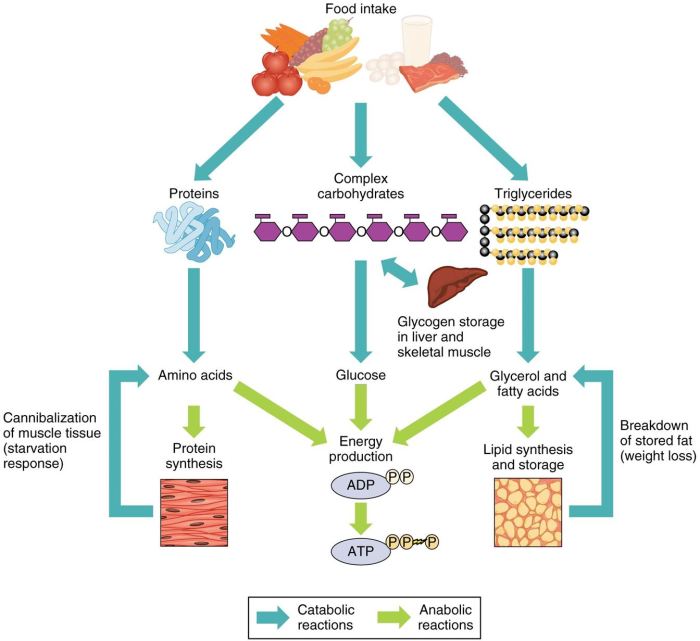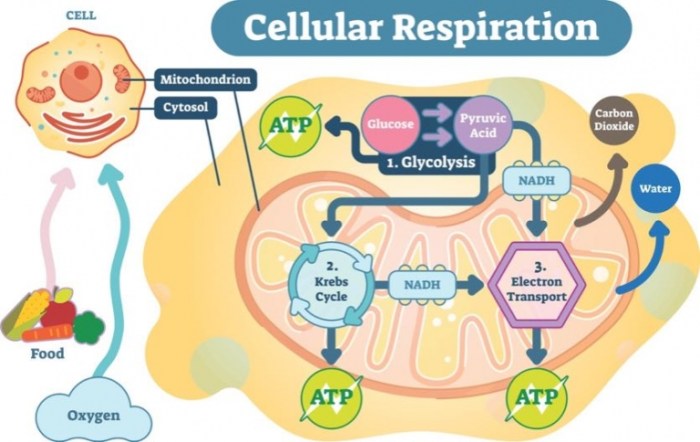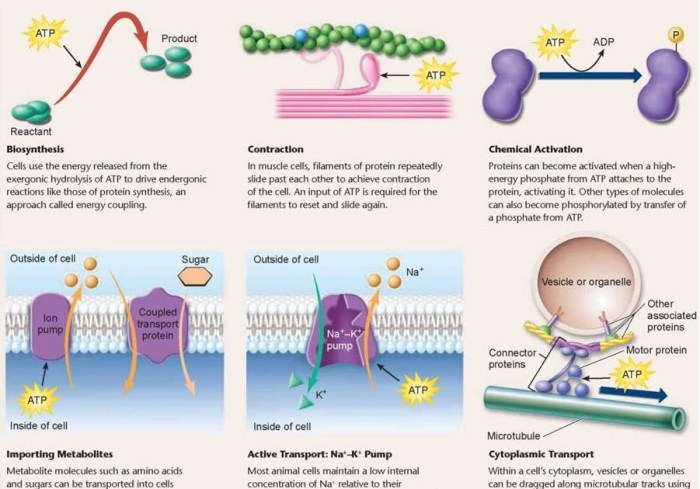Most cells only store enough ATP for a few seconds of activity. This means that cells must constantly produce ATP to meet their energy demands. The production of ATP is a complex process that requires several steps. The first step is the breakdown of glucose, which is a sugar molecule that cells use for energy.
The breakdown of glucose occurs in the cytoplasm of the cell. The second step is the transfer of electrons from glucose to a molecule called NADH. The transfer of electrons from glucose to NADH occurs in the mitochondria of the cell.
The third step is the use of NADH to produce ATP. The use of NADH to produce ATP occurs in the mitochondria of the cell.
The production of ATP is a vital process for cells. ATP is used to power all of the cell’s activities, including muscle contraction, protein synthesis, and cell division. Without ATP, cells would not be able to function and would eventually die.
Energy Storage in Cells

Cellular activities rely heavily on energy, primarily obtained from adenosine triphosphate (ATP), the universal energy currency of cells. ATP comprises an adenine base, a ribose sugar, and three phosphate groups. The energy released during the hydrolysis of ATP’s terminal phosphate bond fuels various cellular processes.
Significance of ATP’s Limited Storage Capacity in Cells
Despite its crucial role, ATP is present in limited quantities within cells. This scarcity ensures efficient energy utilization and prevents ATP depletion, which could halt cellular functions. Cells constantly replenish ATP through metabolic processes, maintaining a dynamic balance between ATP production and consumption.
Cellular Processes that Consume ATP
- Muscle Contraction:ATP provides the energy for myosin heads to interact with actin filaments, facilitating muscle movement.
- Ion Transport:ATP powers ion pumps that maintain proper ion gradients across cell membranes, essential for nerve impulses and muscle contractions.
- Protein Synthesis:ATP fuels the ribosomes during protein translation, enabling the synthesis of new proteins.
- Cellular Motility:ATP drives the movement of motor proteins, allowing cells to move, divide, and transport materials.
- Chemical Reactions:ATP provides the energy required for many enzymatic reactions, facilitating metabolic pathways and cellular processes.
Regulation of ATP Levels

ATP production is meticulously regulated to meet the energy demands of cells. Cells employ several mechanisms to maintain optimal ATP levels.
Feedback Loops
Feedback loops play a crucial role in maintaining ATP homeostasis. When ATP levels drop, enzymes involved in ATP synthesis are activated. Conversely, when ATP levels rise, these enzymes are inhibited. This negative feedback mechanism ensures that ATP production is tightly regulated in response to cellular energy requirements.
Impact of ATP Depletion

ATP depletion has severe consequences for cellular function, leading to a cascade of events that can ultimately result in cell damage and death. When ATP levels fall below a critical threshold, essential cellular processes are compromised, impairing cell viability and homeostasis.
One of the most immediate effects of ATP depletion is the inhibition of energy-dependent ion pumps, such as the sodium-potassium pump. This disruption leads to an influx of sodium ions and an efflux of potassium ions, causing an imbalance in the cell’s electrochemical gradient.
The resulting depolarization of the cell membrane impairs nerve impulse conduction and muscle contraction, among other functions.
Mitochondrial Dysfunction
ATP depletion also affects mitochondrial function. Mitochondria are the primary energy producers in the cell, and they rely on ATP for oxidative phosphorylation, the process by which they generate ATP. When ATP levels are low, mitochondria cannot produce enough energy to meet cellular demands, leading to a vicious cycle of ATP depletion and impaired mitochondrial function.
Protein Synthesis Inhibition, Most cells only store enough atp for
Protein synthesis is another process that is highly dependent on ATP. Ribosomes, the cellular machinery responsible for protein synthesis, require ATP to assemble and translate mRNA into proteins. ATP depletion, therefore, leads to a decrease in protein synthesis, which can have far-reaching consequences for cellular function, including impaired repair and growth.
Cell Death
Prolonged ATP depletion can ultimately lead to cell death. When ATP levels fall below a critical threshold, cells can no longer maintain their structural integrity and metabolic processes. This can lead to cell swelling, membrane rupture, and the release of cellular contents, resulting in cell death.
Cellular Adaptations to ATP Depletion
Cells have evolved mechanisms to cope with ATP depletion and minimize its harmful effects. One such mechanism is the activation of anaerobic glycolysis, a less efficient but ATP-producing pathway that does not require oxygen. Anaerobic glycolysis allows cells to generate ATP in the absence of oxidative phosphorylation, albeit at a lower yield.
Another cellular adaptation to ATP depletion is the upregulation of ATP-generating enzymes. Cells can increase the expression of enzymes involved in glycolysis and oxidative phosphorylation to enhance ATP production. This adaptation helps cells maintain ATP levels during periods of high energy demand or ATP depletion.
Comparative Analysis of ATP Storage Capacity
Different cell types exhibit varying capacities to store ATP, a crucial energy molecule. This variation stems from diverse factors and has significant implications for cellular function.
Factors Influencing ATP Storage Capacity
- Cell size and volume:Larger cells generally have greater ATP storage capacity due to increased cytoplasmic space.
- Metabolic activity:Cells with high metabolic rates require more ATP and thus have higher storage capacities.
- Mitochondrial density:Mitochondria are the primary sites of ATP production. Cells with more mitochondria can produce and store more ATP.
Implications for Cellular Function
ATP storage capacity influences cellular function in several ways:
- Energy buffering:Cells with higher ATP storage capacity can withstand periods of energy deprivation without compromising essential processes.
- Rapid response to energy demands:Cells with ample ATP reserves can quickly mobilize energy to meet sudden energy demands, such as during muscle contraction.
- Cell proliferation and growth:ATP is essential for cell division and growth. Cells with sufficient ATP storage capacity can support these energy-intensive processes.
ATP Storage Strategies

Cells employ various strategies to increase their ATP storage capacity, ensuring a steady supply of energy for cellular processes. These strategies contribute to cellular resilience and survival by enabling cells to respond to energy demands and adapt to changing environmental conditions.
Creatine Phosphate Shuttle
The creatine phosphate shuttle is a mechanism found in muscle cells that facilitates the rapid regeneration of ATP during high-energy activities. Creatine phosphate, a high-energy molecule, acts as a reservoir for phosphate groups. When ATP levels deplete, creatine phosphate donates a phosphate group to ADP, regenerating ATP.
This shuttle system allows for a rapid and efficient replenishment of ATP, sustaining muscle function during intense exercise.
Glycogen Stores
Glycogen, a branched polysaccharide, serves as a primary energy reserve in many cell types, particularly muscle and liver cells. When energy demands increase, glycogen is broken down into glucose-1-phosphate, which is subsequently converted to glucose and enters glycolysis to generate ATP.
Glycogen storage provides a readily available source of energy, allowing cells to respond to sudden energy requirements.
Lipid Droplets
Lipid droplets are intracellular organelles that store triglycerides, a type of fat. Under conditions of nutrient excess, cells convert excess glucose into triglycerides and accumulate them in lipid droplets. When energy demands arise, lipid droplets are broken down through lipolysis, releasing fatty acids that can be oxidized in mitochondria to generate ATP.
Lipid droplets provide a long-term energy reserve, enabling cells to survive extended periods of nutrient deprivation.
Protein Degradation
In extreme conditions, when other energy sources are depleted, cells can resort to protein degradation to generate ATP. Proteins are broken down into amino acids, which can be converted into glucose through gluconeogenesis or oxidized in mitochondria to produce ATP.
Protein degradation is a last resort energy source, employed when cellular survival is at stake.
FAQ Corner: Most Cells Only Store Enough Atp For
What is ATP?
ATP is a molecule that cells use for energy. It is composed of a sugar molecule, a phosphate group, and a nitrogenous base.
How is ATP produced?
ATP is produced through a process called cellular respiration. Cellular respiration is a complex process that occurs in the mitochondria of cells. It involves the breakdown of glucose, a sugar molecule, to produce ATP.
Why is ATP important?
ATP is important because it is used to power all of the cell’s activities, including muscle contraction, protein synthesis, and cell division.